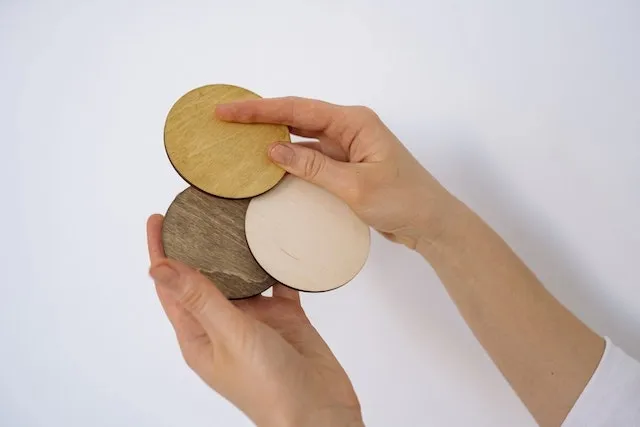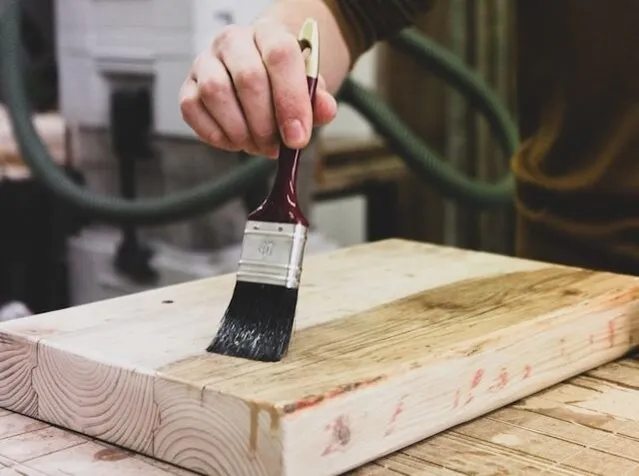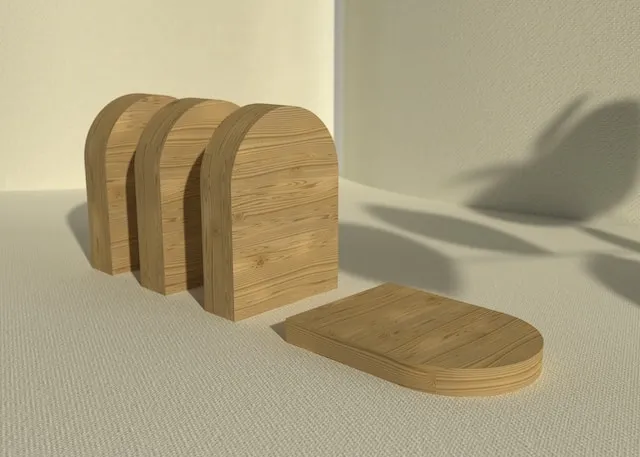How To Make Wooden Coasters Waterproof With Minimal Effort
Wooden coasters are elegant and functional table accessories for your decor but you can extend their lifespan by protecting the material from moisture. In this post, we will explore the question of how to make wooden coasters waterproof. Whether you are crafting your own, or working with some existing coasters, you must get the process right to preserve their beauty and functionality. The appropriate sealant is essential and you need to understand the correct techniques for applying them, so let us provide some guidance on getting this right to get the best finish for your coasters.

Key Takeaways
- You should consider whether or not to stain the wood before applying a sealer.
- Sealants like polyurethane, lacquer, and varnish are all great for adding moisture protection.
- Always prepare the wood first and apply sealant in a well-ventilated area. There are various best practices for applying the finish.
- Hardwoods, as well as cedar and bamboo, all have excellent natural moisture resistance.
- There are many benefits to sealing wooden coasters, but you must still maintain them well.
- Absorbent materials like cork or stone are an alternative approach to coasters.
Table of contents
-
Preparation Before Waterproofing: To Stain Or Not To Stain
-
How To Seal Wooden Coasters
-
Types Of Woods Best Suited For Waterproofing Coasters
-
Why Should You Seal Wooden Coasters?
-
What Are The Benefits Of Making Wood Coasters Waterproof?
-
Maintaining Waterproofed Wooden Coasters To Use For A Long Time
-
How Do You Permanently Waterproof Wood?
Preparation Before Waterproofing: To Stain Or Not To Stain
It may not be a strict necessity to apply wood sealer to your coasters. For instance, when you order custom wood coasters from us, they are already treated for waterproofing.
If you have elegant wooden coasters, you need to consider whether staining is right for you. The color can look appealing, and it will provide extra protection against moisture, but it will also change the appearance of the wood. You need to consider what your coasters are used for, how frequently you use them, and whether you are okay with changing the aesthetic.
To apply wood stain to seal wooden coasters, you must:
- Choose the right wood stain for your needs.
- Sand the coaster lightly to prepare the wood.
- Use a brush to apply the stain, following the wood’s grain.
- Let it dry.
Wood stain will provide limited protection for your coasters, but you will want to add a sealant as well to get the best possible results.

How To Seal Wooden Coasters
The best finish for wooden coasters when trying to make them waterproof is a sealant. You have various options to consider, including varnish, polyurethane, lacquer, and tung oil, each of which offers their own benefits. If you wish to apply one of these products to your wood or custom bamboo coasters, you must ensure you select the appropriate sealant for your material. You must also follow the best practices for application, as well as the specific instructions provided by the manufacturer, and pay heed to special considerations if your coaster is painted.
Read on for some detailed explanations about how to use wood coaster sealant for waterproofing your wooden coasters. If you would prefer not to have to worry about this, explore our custom coaster design service to have high-quality wood coasters made with excellent water-resistance.
Using Sealants For Waterproofing
Before you apply any type of sealant, you must clean your coaster. Use the best method for your material type and allow it to dry fully so that no residue, debris or moisture is trapped beneath the sealant. The most common types of sealant to make wooden coaster waterproof are polyurethane, lacquer, varnish and tung oil. Here are some guidelines for each:
- Polyurethane: Suitable for most wood types, including oak, cherry, walnut, and birch. Sand the wood lightly first and apply with a brush in a thin, even coating. Dry for 24 hours (or in accordance with manufacturer instructions).
- Lacquer: Ideal for wood with a smooth and even surface, including cherry, oak, and walnut. Again, gently sand the wood’s surface and apply with a brush.
- Varnish: This is best for hardwoods or plywood. You will need to follow the manufacturer instructions for preparing the wood and applying the varnish, and it may require multiple coats.
- Tung oil: This is great for preserving natural character in wood, so use on hardwoods, exotic woods or reclaimed wood for best results. The manufacturer instructions will guide you for application methods and drying times.
Each is better suited to different situations and offers its own aesthetic finish. All will provide good waterproofing, so the best finish for wooden coasters comes down to personal preference.
Best Practices For Application
Not all wooden coasters require you to apply a sealant. If you only use them occasionally, it is unlikely they will be damaged by that minor exposure to moisture. And, if you order your custom beer coasters from us, they will already be sealed and fully protected against moisture spills.
Only you will know if your coasters need this extra layer of protection. If you come to the conclusion that you do need to apply wood coaster sealant, here are some general best practices for applying sealant to make wooden coasters waterproof.
- Prepare the wood first: This means washing and drying it, and perhaps also lightly sanding it to create a smooth surface.
- Consider staining: If you intend to use wood stain, apply it before you add the sealant.
- Use the right sealant: This depends on your coaster type, so do your research and find what sealants work well for the wood.
- Ventilation: Always apply the sealant in a well-ventilated area.
- Apply evenly: Use a brush, foam applicator, or dry cloth to apply the sealant evenly over the coaster’s surface.
- Dry and cure: The manufacturer instructions will tell you how long your sealant needs to dry and cure. Leave it in a clean, dry space away from direct sunlight while it cures.
Once the sealant has hardened, your wooden coaster will have a new, glossy aesthetic and it will have reliable protection against water.
Special Considerations For Painted Coasters
The general process for adding wood coaster sealant to a painted wooden coaster is basically the same. But there are a few special considerations that will ensure you protect the coaster and preserve the beauty of the paintwork upon it. Bearing in mind what coasters are used for, the importance of preserving the aesthetic as well as boosting the protection they offer is clear, so act with care.
- Compatibility: Some sealants may not be compatible with the paint you used. Water-based sealants typically work well over water-based paints, while oil-based sealants are good for oil-based paints.
- Thin coats: Thicker coats can result in a cloudy or streaky finish. It’s better to apply multiple thin coats to preserve the look of the paintwork.
- Clean brushes: As a flawless finish is desired, you must use clean brushes for each coat and be sure to rinse them thoroughly between coats.
Heed this advice to get the best outcome from your finish.

Want custom wood coasters that are already waterproof?
We seal our customized wooden coasters after adding your design to ensure a professional look and optimal performance, all at a competitive price for your convenience.
Types Of Woods Best Suited For Waterproofing Coasters
In learning how to make wood coasters waterproof, it’s helpful to know the best wood for coasters that are resistant to water damage. Whether you are making your own coasters or ordering custom aesthetic coasters from us, you have many woods available to you. And there are numerous excellent wooden coaster design ideas to consider. Here are some woods that have good natural water-resistance or are easy to seal:
- Hardwoods: With their dense structure, woods like oak, maple and walnut are resistant to moisture. They are also relatively easy to seal with their non-porous nature.
- Cedar: The natural oils of cedar wood make it excellent for outdoor use. With the right sealant, cedar coasters are exceptionally resistant to water.
- Bamboo: While not technically a wood, bamboo is known to be resistant to moisture. It is also sustainable and aesthetically-pleasing, and can be easily sealed with water-based polyurethane.
We supply custom coasters in these materials and take extra steps to ensure their durability and aesthetic qualities.
Why Should You Seal Wooden Coasters?
There are various advantages to sealing wooden coasters. Whether you are learning how to make tea coasters or exploring ways to improve ones that you already have, here are the reasons to use wood coaster sealer on your wooden products:
- It protects against moisture: With regular use, a wooden coaster is frequently exposed to moisture and spills. This can stain or warp the wood over time, thus ruining the coaster.
- It can boost the aesthetic of a coaster: Applying sealant can be the best finish for wood coasters. It gives them a glossy look and, when combined with staining, results in a more sophisticated aesthetic.
- It enhances the longevity: With protection against moisture and other contaminants, your coaster becomes more resilient and its lifespan is likely to increase.
Essentially, sealing wood coasters makes them last longer and preserves their aesthetic.
Create a wood coaster that is naturally waterproof
Our custom bamboo coasters look just like wood but they are more sustainable and durable. They are also naturally waterproof, and can feature your personalized designs.
Create yours todayWhat Are The Benefits Of Making Wood Coasters Waterproof?
When you learn how to make wooden coasters waterproof, you have the power to apply that knowledge to reinforce your coasters. The benefits of this are numerous:
- It extends their lifespan.
- They become easier to maintain.
- Their stain resistance improves.
- You get more durable coasters.
- The aesthetic is improved and preserved.
- Versatility increases - you could even use them outdoors.
Waterproofing can prevent the development of mold, mildew and bacteria on the coaster.
Maintaining Waterproofed Wooden Coasters To Use For A Long Time
Coaster maintenance is important whenever you have coasters in your space. If you have applied wood coaster sealer to yours, it’s crucial to use the right methods to look after your coasters. It’s not complicated, but you should try to commit to regular maintenance:
- Cleaning your coasters: Clean the coasters regularly. Learn how to clean drink coasters for best results using mild soap and water, and always allow them to air dry fully.
- Avoid excessive heat exposure: If you place hot objects on a sealed coaster, it may discolor the sealant and leave an unsightly mark. Warm beverage containers should be fine, but keep away the very hottest items.
- Repair if necessary: Sometimes, thorough general wear and tear, parts of the sealant layer may become chipped or damaged. You can touch these up by applying some more sealant to ensure the moisture protection is not compromised.
With a little basic care and attention, maintaining your sealed wooden coasters is easy.
What Is The Best Waterproof Finish For Wood Coasters?
The best waterproof finish for your wood coasters really depends on the type of wood you are using and your personal preferences. The options we have covered in this post make up the leading choices, and they include:
- Polyurethane
- Varnish
- Tung oil
You could also consider using shellac, epoxy resin, or acrylic paint and sealant for a colored finish. You need to do a little research about your wood type and its compatibility with different types of sealants to narrow down your options.
What Is The Best Absorbent Material For Coasters?
Some people choose to make or order coasters in an absorbent material. The benefit is that these materials help prevent spills from reaching your tabletop by absorbing them rather than allowing them to sit on the surface. This is great for your tabletops, but it does make the coasters more vulnerable to staining from wine or tea spills, or to the development of mold and mildew.
That said, there are some great absorbent coaster materials that are resistant to these issues:
- Cork: Cork absorbs moisture and is resistant to damage from it. It is also easy to clean and a highly sustainable material, making it very popular for buyers.
- Stone: Another natural material, stone can absorb moisture with very little risk of being damaged by it.
We supply both these types of coasters, fully customizable to make them work for your space. Cork is the more cost-effective option, while stone has an elegant aesthetic. Choose in accordance with your needs.

Want a waterproof alternative to wooden coasters?
Work with us to create custom acrylic coasters for a durable, affordable option to add personalized coasters to your table settings. They are lightweight and stylish accessories.
How Do You Permanently Waterproof Wood?
The sealants we have discussed in this post are all permanent solutions for how to make wood coasters waterproof. With ample diligence throughout the process of applying the sealant, you will have a permanent solution that protects your coasters from moisture indefinitely.
The only thing that can break that permanence is failure to maintain the coasters. They need to be looked after to preserve the integrity of the protective layer. When you order from us, you get a highly durable finish and comprehensive instructions on how to care for your coaster so that it remains in top condition for the long haul.
Frequently Asked Questions About How To Make Wooden Coasters Waterproof
What Is The Best Waterproof Finish For Wood Coasters?
This depends on the type of wood your coaster is made from. All the sealants in this post create a high-quality finish, so choose the optimal one for your specific coasters.
What Is The Best Absorbent Material For Coasters?
Cork and stone are two superb absorbent coaster materials. They are sustainable and highly absorbent, yet they are unlikely to be damaged by the moisture they absorb.
What Are The Benefits Of Making Wood Coasters Waterproof?
By making them waterproof, you enhance the aesthetic of your coasters and protect them against damage from moisture. You also extend their durability, maximizing your value for money.